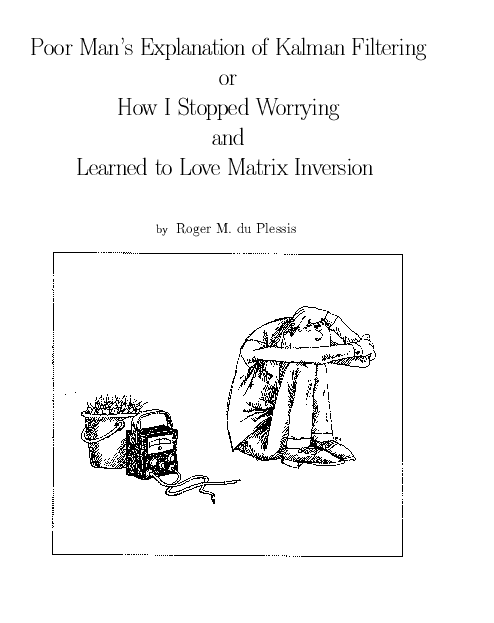 |
We do the math so you don't have to! | ||||||||||||||||||||||||||||||||||||||||||||
|
|||||||||||||||||||||||||||||||||||||||||||||
Poor man's explanation of Kalman Filters
or
How I stopped worrying and learned to love matrix inversion

The Kalman Filter was invented to solve a problem in spacecraft navigation, but the technique is relevant not only to navigation but also to other problems where incomplete or inconsistant observations must be combined with a (possibly incomplete) state of a system. This includes such problems as sensor fusion, robot state estimation, combining oceanography and meteorology observations with models, data assimilation and adaptive estimation/controls.
A realtime version of the Kalman filter was used by Taygeta to control the autonomous parachute.
The paper du Plessis, R.M., 1967; Poor man's explanation of Kalman Filters or How I stopped worrying and learned to love matrix inversion is a must have classic. It is the starting point for all of the above problems. It belongs on the bookshelf of every engineer.
Taygeta Scientific Incorporated, has aquired the rights to republish the report. And now has typeset and reprinted it (the reprint consists of the original report, and a bibliography. It has the ISBN number, 0-9661016-0-1). For $24.95 you can now get your very own copy!
To order please visit our Square store
From the introduction:
Dr. R. E. Kalman introduced his concept of optimum estimation in 1960. Since that time, his technique has proved to be
a powerful and practical tool. The approach is particularly well suited for optimizing the performance of modern
terrestrial and space navigation systems.
Many people not directly involved in systems analysis have heard about Kalman filtering and have expressed an interest in
learning more about it. Although attempts have been made to supply such people with simple, intuitive explanations of Kalman
filtering, it is this writer's opinion that none of these explanations has been completely successful. Almost without exception,
they have tended to become enmeshed in the jargon and state-space notation of the ``cult''. But matrix notation, regardless of
how useful and efficient it may be, does not assist the uninitiated reader to understand the concepts.
Surprisingly, in spite of all the obscure-looking mathematics (the most impenetrable of which can be found in Dr. Kalman's original
paper), Kalman filtering is a fairly direct and simple concept. The full-blown matrix equations can be made intelligible by being
presented in a way that appeals to the intuition, and a statistical error analysis or actual system performance data can be viewed with
an intuitive understanding of the results.
The present paper presents a straightforward explanation of Kalman filtering that will be accessible to virtually all readers. The most
salient features are explained by means of a very simple example, entirely free from matrix notation and complicated dynamics. A second
illustrative example is taken from the field of inertial navigation, since this is one of the most fruitful areas of application for Kalman
estimation. This slightly more complicated second example is used to describe more of the concepts and terminology of Kalman filters
(e.g., ``state vector'', and so forth). At the same time, it permits a closer look at the actual operations involved in applying Kalman
theory. Not all readers will have the familiarity with matrix notation or the patience to unravel every single equation in the discussion of
the second example. The writer feels, however, that the gist of this discussion will be grasped by the majority of those readers who are
analytically inclined.
The main body of the paper concludes with qualitative comments concerning the practical advantages and disadvantages of the Kalman technique
and the difficulties of applying it in actual systems. Again, navigation systems are particularly cited.
Finally, an appendix defines a criterion for optimum estimation and derives the optimum estimation equations used in the examples. As is
the case with the main body of the paper, the appendix is intended to be tutorial and to provide, for those readers who can recall some
of their probability theory, a thumbnail derivation of the estimation equations.
-
 Taygeta Kalman Filter Page.
Taygeta Kalman Filter Page.
About | Services | Research | Store | Contact | Home | Stargate